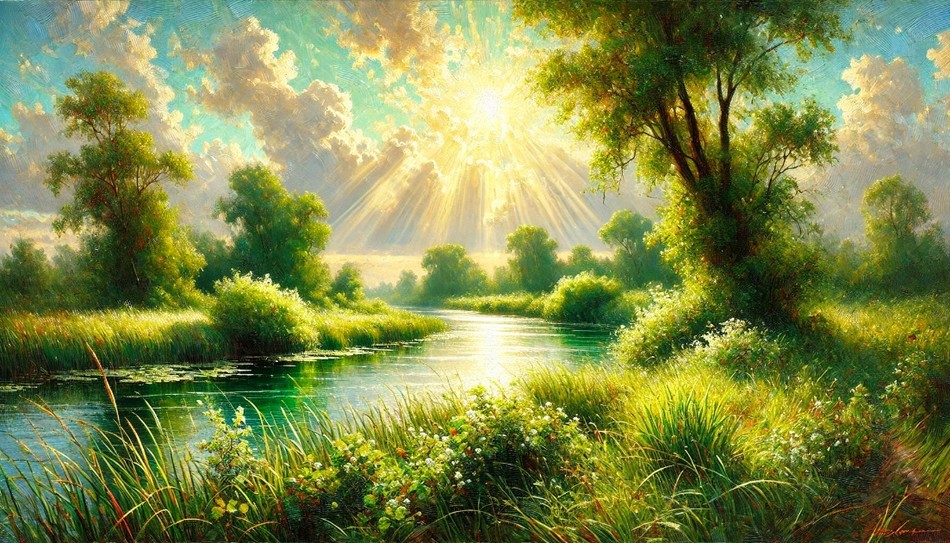The Bible is a divine story, God’s supernatural plan from creation to redemption, with the Fall and struggle in between. This heavenly story, however, occurs within limited time and actual space, with people living lives in real places. The theme of heaven meeting earth runs through the whole text, through various genres and history. It begins with God’s Spirit hovering over a chaotic world and speaking life into it, and it ends with a new earth with a grand city descending from heaven to a new, redeemed earth.
This mix of heaven meeting earth elevates common places to greater and more spiritual importance. If God does nothing by accident, and the Bible is Spirit-inspired, then places Scripture mentions have more meaning than surface level.
From the start, God placed a people within a place, the Garden of Eden, and Scripture says rivers flow from the garden. One of those is the mysterious Pishon River.
Where Does the Bible Mention the Pishon River?
Genesis 2 mentions the four rivers flowing from Eden, and verse 11 says, “The name of the first is Pishon; it winds through the entire land of Havilah, where there is gold.”
Scholars aren’t sure what “Pishon” might mean, but they have several possible interpretations. Some link it to an ancient word meaning “to gush” or “spring forth.” For a related meaning, others think it could mean “overflowing” or “spreading,” which might emphasize the river’s movement and life-giving properties.
In context, Genesis mentions Pishon to reveal how Eden overflows with life. Not only did God create and design the Garden of Eden to be a heaven on earth, great rivers began there, reaching out to spread to other lands. The Bible further points out how Pishon flowed to Havilah, a land of gold and riches.
What Do the Four Rivers from Eden Represent?
Four total rivers flow from Eden—Pishon, Gihon, Tigris, and Euphrates. These actually began as one river from Eden and split into four.
On the surface, the rivers simply reveal a literal geographical description, giving the reader a sort of geographical marker for the Garden’s location. The Tigris and Euphrates were still well-known centuries later in Moses’ day. Many scholars believe the other two were once real but later dried up or changed names.
Others suggest these two might represent symbolic rivers. The four rivers represent godly life and provision. One single river becomes four, flowing out to different areas and regions, symbolizing Adam and Eve’s commission from God. The Lord commanded the first married couple to be fruitful and multiply, literally have kids, and go from the Garden, filling the earth with people made in God’s image. The four rivers signify blessing, going in different directions to bring God’s life to the earth. Psalm 46:4 expresses a similar idea: “There is a river whose streams make glad the city of God.”
Many Jews and early Christian theologians allegorized the four rivers, linking them to the four corners of the earth or the four directions. Others connected them to the four Gospels, further seeing a connection to another commission: Jesus sending his disciples to spread God’s Word to people in every nation. To further show this biblical theme, God’s covenant to Abraham was that all nations would be blessed through him and his descendants.
Of course, we don’t have to choose between the physical and symbolic. The four rivers can be both physical realities at creation and symbolic for God’s plan to bless the world.
Where Did the Pishon River Flow?
While the exact location of the Pishon and Havilah Rivers remain unknown, scholars propose several possibilities.
Some scholars think the Pishan flowed down through Arabia, connecting Havilah with the western part of the peninsula. Historical references used “Havilah” for modern-day Saudi Arabia or Yemen. That area also had known gold deposits and trade routes, which supports this idea.
In the 1990s, geologist James Saur and a satellite imagery specialist, Farouk El-Baz, used NASA images to find a dry riverbed called the Wadi al-Batin and Wadi Rimah. These former riverbeds stretched from the Hijaz mountains through Kuwait. Since these areas are located near the Tigris and Euphrates, and match the direction and region mentioned in Genesis, the two scientists argued this could be the ancient Pishon River. It provides further evidence for the Arabian theory.
Others have tried to trace the Pishon into northeast Africa, linking it to rivers near Nubia or Sudan, because many think humanity began around this area. Therefore, they try to connect Eden to this area, but this theory isn’t widely accepted.
Of course, many think Pishon never existed but is symbolic and allegorical, representing an idealized river of life.
Why Can We Not Find This River Today?
We have to remember, the story of the Pishon River comes from a time before Noah and the Great Flood. A worldwide flood would have had dramatic results on the landscape, so natural events or other environmental shifts could have led to the Pishon disappearing.
As mentioned above, a popular theory holds that the Pishon simply dried up over time, which we see evidence of in the Middle East and Arabia. Thousands of years ago, during a wetter climate, these dried-up riverbeds once carried large amounts of water and supported settlements in the region, although now they are much more arid.
People should also consider tectonic activity and shifting land. Earthquakes, volcanoes, and continental drift make major changes to the landscape. Over thousands of years, the original river courses may have been buried, rerouted, or erased. The area described in Genesis might be unrecognizable to us today because of such shifts. We have evidence of this happening with other rivers in history.
Others look at the Pishon symbolically, seeing the river not as one to be rediscovered but as a picture to be interpreted and inspired by.
How Do These Rivers from Eden Connect to the River in Revelation 22?
In Genesis, a single river flows from Eden and divides into four: Pishon, Gihon, Tigris, and Euphrates. In Revelation 22, a pure river of life flows from the throne of God and the Lamb, running through the New Jerusalem out to the New Earth.
These two river scenes form amazing bookends to God’s redemptive story. In Eden, Adam and Eve had a perfect relationship and fellowship in a paradise of living water. But through the Fall, when Adam and Eve sinned, humanity lost access to heaven on earth in the Garden of Eden. Instead of living in such perfect union with God, others, and the environment, humanity experienced hostility and enmity between themselves and God, between each other, and the land itself became hostile. They had to work for their sustenance. Eden and the four rivers became a story of a lost world.
In Revelation, God gives it back. God’s ideas are the best, and he doesn’t give up on them. He wanted a place where he enjoyed intimate relationship with a people in a perfect world on earth. And his redemptive plan moves us forward to that.
But Revelation doesn’t reveal a copy of Eden. Similarities exist, but he creates something even better—a fully redeemed creation where the curse of sin and death is broken, and we live in eternal life. All this has become possible through the work of the Lord Jesus Christ in his death and resurrection.
Therefore, the Revelation 22 river looks like Eden’s but with a clearer Christ-centered meaning. The new river doesn’t flow from a garden but from God’s throne. Jesus is the source of life. On either side of the river stands the Tree of Life, also once lost with the Garden but given back freely in this new place. The river and the tree together clearly declare how God will bring his original design back to us and this world anew.
God restores what was lost. He loves and redeems completely, doing something even greater in his salvation than what was lost. And we participate in this story now through carrying God’s presence with us to the world, blessing the nations, and telling them to drink of the immortal water he offers through Christ.
Peace.
Image created using DALL.E 2024 AI technology and subsequently edited and reviewed by our editorial team.




